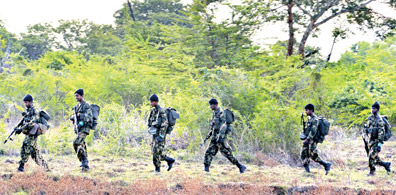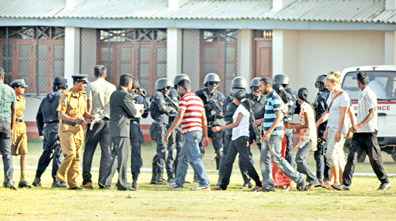Strike Force Command:
They came, they saw, they conquered!
By Shanika SRIYANANDA
 News
broke that the Red Land forces were taking some top foreign officials
and a few locals hostage. They were held hostage in a pavilion of a
sports stadium, at a strategically important location. News
broke that the Red Land forces were taking some top foreign officials
and a few locals hostage. They were held hostage in a pavilion of a
sports stadium, at a strategically important location.
It was confirmed during the height of the operations that due to the
setbacks suffered by Red Land, it was a do-or-die situation for them.
In the wake of the new developments and the unfavourable situation
they faced, the Red Land Forces with the help of the Scorpions took them
hostage as a last resort to stop the onslaught by the Blue Land Forces.
It was also confirmed that about 21 Blue Landers were taken as
hostage and were in the custody of the Red Land Forces. They had killed
about 3 officers during interrogation. With this latest tactic adopted
by the Red Land Forces to take civilians and foreigners hostage, it
disturbed the normalcy of Blue Land.
 Blue
Land and Red Land, which belonged to one island some years ago had
historically deep-rooted animosity, hatred and mistrust among the two
states due to their fights over natural wealth. Blue Land, which is
economically sound, gained wealth due to its large mineral deposits –
Silica, Ilmenite and other minerals in the Eastern territorial waters. Blue
Land and Red Land, which belonged to one island some years ago had
historically deep-rooted animosity, hatred and mistrust among the two
states due to their fights over natural wealth. Blue Land, which is
economically sound, gained wealth due to its large mineral deposits –
Silica, Ilmenite and other minerals in the Eastern territorial waters.
It owns a strategically important harbour , which is one of the most
profitable international shipping hubs. Red Land demanded for an equal
share of hydrocarbon resources, which was discovered in the territory of
Blue Land.
Many times the two groups fought over borders and the wealth of
natural resources.
In the decade-old disputes, Red Land aimed to expand their borders
and also capture sensitive areas, which are of economical importance, of
Blue Land.But Blue Land’s military, which aimed to establish territorial
integrity of the country, wanted to end the disputes for the benefit of
the country’s economic growth by securing its oil and gas reserves.
Within a few hours after the bad news about taking its people hostage,
the Blue Land military implemented a daring mission to rescue the
victims.
The Blue Land military chief instructed to mobilize its highly
skilled professional soldiers – the Commandos – to counter terrorists
and rescue the hostages. Due to the nature of the complexity of the
rescue mission, which is to be carried out in a location situated in the
centre of the town, more snipers were used to gather-real time
information and maintain surveillance. The assault men are highly
trained and mastered the skills of sharp shooting in close quarter
combat.
It was on the afternoon of September 3 that the Blue Land Forces
attacked a the vital point – the pavilion of the McHeyzer Stadium in the
heart of the Trincomalee town to rescue hostages. Assault men rush into
a room full of armed men behind closed doors, in a almost kind of
unconcern for one’s own life, with a devil-may-care attitude, ultra
quick reflexes, ability to take in a scene in minimum time and start
shooting without harming innocents and capacity for unarmed hand-to-hand
combat.
The sharp targets of the snipers killed the Red Land soldiers who
were guarding the pavilion.
Supported by the Air Force AN 32, Bell 212 and MI 17, the well
trained Blue Land soldiers landed on ground and surrounded the stadium
without leaving breathing space for the Red Land soldiers to retaliate.
In a 15-minute rescue mission, the Blue Land forces rescued all the
hostages without any harm and captured the strategically important place
in the heart of the city.
After some years of wiping out LTTE terror, people living in the
vicinity of the Trincomalee town recalled their fear-filled days.
Soon they felt that it was the final episode of the three-week long
joint military exercise, ‘Cormorant Strike II - 2011’ by the Sri Lanka
Army, which brought over 3,500 military men including Navy and Air Force
into one fold to keep up their readiness to face counter-terrorism and
also hostage rescue missions in any given such occasions.
 The
Army’s elite Commandos and Special Forces soldiers were mainly engaged
in the training which was mainly focused on an amphibious operation. The
Army’s elite Commandos and Special Forces soldiers were mainly engaged
in the training which was mainly focused on an amphibious operation.
The main purpose of the joint training exercise is to give
anopportunity for the elite forces of the country’s tri-services to
carry out training in a near realistic semi conventional operational
environment to broaden their understanding and sharpen the skills
necessary for possible eventualities.
Among the objectives of launching the Cormorant Strike was to give
the opportunity to Commandos and soldiers of the Special Forces to
enhance practical knowledge in decision making, to understand the
conduct of integrated sea and air operations and to expose commandos in
the nature and conduct of joint operations and educate special forces on
the capabilities, limitations and resources of sister services.
The elite Blue Land soldiers completed their hostage rescue mission
successfully in the presence of the Army Chief Lt. Gen. Jagath
Jayasuriya, the Defence Attachés from US, Russia, Japan, Pakistan, India
and Bangladesh and other senior tri-service officers.
Apart from commandos and special forces, a large contingent of I
Vijayabahu Infantry Regiment (VIR) and 20 Gajaba Regiment (GR) took part
in the exercise. Over 110 officers of the Commando Regiment, 90 officers
of the Special Forces, 400 sailors and 150 Air Force personnel, in
addition to some 2750 Other Ranks in the Army engaged in the exercise
ended last Sunday.
Cormorant Strike, which is the brainchild of Secretary Defence
Gotabaya Rajapaksa, had its first event in Mannar and Mullaitivu in
2010. The exercise, which was launched under the guidance of ArmyChief,
conducted mock ‘Raids on boat yards’, ‘Taking of high value targets’,
‘Reconnaissance’, ‘Surveillance on targets’, ‘Airborne operations’,
‘Seaborne operations’, ‘Amphibious landing’, ‘Path-finding missions’,
‘Para jump into enemy strongholds’, ‘Ambushes’, ‘Search operations’,
‘Counter terrorist actions and Hostage Rescue Mission’.
Brigadier K.P.A. Jayasekara, Director, ‘Exercise Cormorant Strike II
- 2011’ and Special Operations Commander said the exercise commenced
August 22 between Trincomalee, Mullativu and PadaviParakramapura with
the participation of the Special Forces of the Sri Lanka Army, Special
Boat Squadron of the Sri LankaNavy assisted by the Sri Lanka Air Force.
Exercise area
 “The
exercise area spread over 7500 sq km covering 3 administrative districts
of the country which provides ample space for the small group covert
operation of Special Operational Forces. “The
exercise area spread over 7500 sq km covering 3 administrative districts
of the country which provides ample space for the small group covert
operation of Special Operational Forces.
The Operations environment of the Exercise is to deliberately
designed as a semi conventional; combining both conventional and
insurgency situations, to be realistic and to simulate most likely
future battle environments”, he said.
According to Brig. Jayasekara the elite element of the Sri Lanka
Navy, the Special Boat Squadron which comprises highly trained and
skilled men with high tech speed crafts for shallow water special
operations was continuously employed throughout the period of operation
with consistent success. “Over 40 naval vessels including Shakthi,
Ranavijaya, Ranagaja, the Fast Missile vessels (A unit of inshore patrol
crafts), Fast attack boats (Arrow Boats) are taken for the exercise.
The Sri Lanka Air Force played a critical role in the overall
operational plan by maintaining aerial surveillance, providing close air
support, conducting air interdictions and transporting men, material and
equipment necessary for the troop buildup and their sustenance in the
enemy’s rear”, he said adding that the snipers and assault men are being
used on this operation design combination of open air sniper option and
building intervention, precisely coordinate with air component where
success depends on close coordination and corporation between all
agencies involved in hostage rescue operation.
The Commando Brigade mobilised 14 LRP Detachments, 11 Hostages Rescue
Team and 9 Squadrons in to the operational are to carry out deep and
decisive operations. Troop inductions took place mostly in the hours of
darkness through Air and Naval means, and through land infiltrations.
“Hostages rescue operations are the most difficult type of special
operation missions.
They require absolute precision and demand a specific type of force
with attributes and capabilities that distinguish them from conventional
forces or even regular Special Operations Forces.
 The
special skills required by a rescue force suchas specialized shooting
techniques, breaching, technical and tactical surveillance, and close
quarter battle are even more technical and sophisticated than those
required of regular SOF units”, Brig. Jayasekara said. The
special skills required by a rescue force suchas specialized shooting
techniques, breaching, technical and tactical surveillance, and close
quarter battle are even more technical and sophisticated than those
required of regular SOF units”, Brig. Jayasekara said.
According to Director of the exercise, the most important part of a
rescue operation was saving the lives of hostages.
The Broader concept of the Hostage Rescue Operations are common to
all specialised units worldwide and an operational plan for a specific
mission is formulated with the right blend of such universally accepted
know-how, expertise and the resources available with the action force.
Use of force in a hostage crisis situation is considered the last
resort which will be ordered by the highest strategic decision makers”,
he said.
In the ‘Cormorant Strike’, soldiers of tri-forces had spent eight
days for planning and 14 days in the jungles fighting with the enemy.
Among the exercise controlling authority were the Director Operations
Brig. Nirmal Dharmarathna, overall Operations Commander (Eastern Naval
Area) Rear Admiral J.S.K. Kolombage, Group Captain R.A.U.P. Rajapaksa,
and Special Forces Commander Col. Harendra Ranasinghe.
The hostage rescue operation was conducted under the command of Lt
Col Gnanarathne under the instructions of Commando Brigade Commander
Col. Lalantha Gamage.
|

